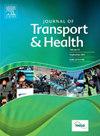Determinants of active school travel levels among children: A case study in a mountainous city
IF 3.2
3区 工程技术
Q2 PUBLIC, ENVIRONMENTAL & OCCUPATIONAL HEALTH
引用次数: 0
Abstract
Introduction
Children's active school travel (AST) is crucial for their daily physical activity, especially in mountainous cities where terrain complexities such as slope and road density are closely associated with safety and efficiency. Understanding these relationships is essential for preventing childhood obesity, reducing depression, and enhancing independence. However, AST in mountainous cities has received relatively little attention.
Methods
This study explores the factors associated with children's AST levels in Guiyang, a typical mountainous city in China. Utilizing data from 2021 resident travel survey, we calculate the daily cumulative time spent walking or cycling to and from school as a quantitative measure of AST levels by analyzing children's complete travel chains. This variable serves as the dependent variable in our analysis. A Gradient Boosting Regression Tree (GBRT) model is employed to capture the nonlinear and interactive relationships between children's AST levels and their socioeconomic characteristics, built environment, and topographical features.
Results
The results indicate significant nonlinear associations and threshold effects among the examined factors. In particular, topographical features show strong associations with variations in children's AST levels.
Conclusions
By revealing critical nonlinear relationships and threshold effects related to built environment and topographical factors, this study provides actionable, data-driven insights. These findings can inform more targeted infrastructure and road network strategies to enhance AST among children in mountainous cities.
儿童积极学校旅行水平的决定因素:一个山区城市的案例研究
儿童的主动学校旅行(AST)对他们的日常身体活动至关重要,特别是在地形复杂性(如坡度和道路密度)与安全和效率密切相关的山区城市。了解这些关系对于预防儿童肥胖、减少抑郁和增强独立性至关重要。然而,山区城市的AST受到的关注相对较少。方法探讨中国典型山地城市贵阳市儿童AST水平的影响因素。利用2021年居民旅行调查的数据,我们通过分析儿童的完整旅行链,计算每日步行或骑自行车往返学校的累积时间,作为AST水平的定量衡量标准。这个变量在我们的分析中充当因变量。采用梯度增强回归树(GBRT)模型捕捉儿童AST水平与其社会经济特征、建成环境和地形特征之间的非线性交互关系。结果各因素之间存在显著的非线性关联和阈值效应。特别是,地形特征显示与儿童AST水平的变化密切相关。通过揭示与建筑环境和地形因素相关的关键非线性关系和阈值效应,本研究提供了可操作的、数据驱动的见解。这些发现可以为更有针对性的基础设施和道路网络战略提供信息,以提高山区城市儿童的AST。
本文章由计算机程序翻译,如有差异,请以英文原文为准。
求助全文
约1分钟内获得全文
求助全文

 求助内容:
求助内容: 应助结果提醒方式:
应助结果提醒方式:


